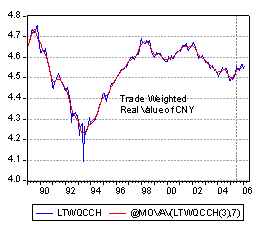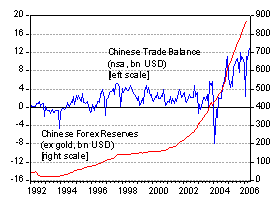The Yuan has not been moving much. Or has it? And does it matter much for the U.S. current account deficit
Secretary of Treasury Paulson’s comments yesterday refocused attention on the Renminbi (from Reuters):
[Paulson] repeated calls for more “flexibility” in China’s currency policy — a veiled message to allow the yuan to strengthen and the dollar to weaken — but he also stressed the need for the world’s fourth largest economy to make progress on other capital market reforms.
The conventional wisdom has it that the Chinese currency, the Renminbi, has not been moving much since the Chinese authorities moved to a crawling peg in July last year. In one sense, this is indisputable, as seen in the blue line in the figure below (the exchange rate is expressed as USD per Yuan, so a movement up is an appreciation of the Yuan).

Figure 1: Bilateral nominal and log real USD/CNY exchange rate. Source: IMF International Financial Statistics, CEIC, ADB-ARIC, FRED II, and author’s calculations.
Of course, what potentially matters more, for purposes of affecting trade flows (which seems to be the main focus of interest) is the real, or inflation adjusted, exchange rate. This is displayed as the red line in Figure 1; as there is lots of volatility imparted by the monthly CPI movements, a centered 7 month moving average is displayed as the green line. There has been some appreciation since last year, but clearly not a large amount. In fact, since June 2005, there has been a 1.8% appreciation as of May 2006 (calculated in log terms).
Before one gets too exercised, however, it is important to recall that China does not trade solely with the U.S. What basic macroeconomics tells us is that macro policymakers should be concerned with the relative price of Chinese goods vis a vis all other trading partners. That is, we should focus on the trade weighted effective exchange rate. Figure 2 presents this series for China.

Figure 2: Log trade weighted real value of the CNY. Source: IMF International Financial Statistics.
As of March 2006, there has been a 3.5% appreciation by this more relevant criterion. Does this mean that sufficient progress has been made?
This question presupposes there is a currency misalignment. But as I have stressed in previously [pdf], one has to be very careful when asserting currency misalignment, as the finding depends upon the eocnomic model being used, and the conditions being assumed in making the assessment.
If one takes the the current extent of capital controls as given, and assumes the repression of the financial system is able to control the manifestation of contingent liabilities, and on top of that takes the internal equilibrium as holding (this last point relates to Frankel’s observation [pdf] that one variable like the exchange rate, cannot hit two targets, like output and external balance), then one can look at the trade balance and forex reserves as indicators of currency misalignment. (For more on the discussion of what currency misalignment means, see this post.)

Figure 3: Monthly trade balance, in billions of USD, and gross foreign exchange reserves ex gold, in billions of USD. Source: Customs Statistics China and IFS via ADB-ARIC.
Both of these indicators would seem to indicate further Yuan appreciation is necessary to restore external equilibrium, an argument that Brad Setser has put forward, and I tend to agree with. But all those conditions stated above should give one pause for thought. Investor reassessment of the extent of nonperforming loans, combined with the discovery that capital controls are actually less effective than thought, might very well lead to the currency being overvalued.
It is important to realize that appreciation is not a panacea for the U.S. trade deficit. According to one of the most careful econometric studies that I know of, Marquez and Schindler [pdf]conclude that a 10% appreciation of the Yuan induces a half of 1 percentage point reduction in China’s share of world exports, and 1/10th of 1 percentage point reduction of world imports. Since world exports and imports of goods and services (goods) are estimated to be about 13.7 (10.5) trillion in 2006 (April 2006 WEO database, adjusted by a 0.77 ratio to convert to goods), this means a 10% appreciation would induce only a $52.7 billion reduction in Chinese goods exports to the world and 10.5 reduction in imports. Assuming this latter anomalous effect is due to distortions associated with the state owned enterprises in earlier years, I’ll drop this effect for the sake of argument. Since the 2006H1 trade balance was $61.4 billion, or $122.8 billion annualized, this means around 40 percent of the trade surplus would be eliminated. Of course, not all of that benefit would redound to the US. And to put things in perspective, $52.7 billlion is about 6% of the $864 billion U.S. current account deficit projected (April 2006 WEO database) for 2006.
The Chinese Yuan is probably overvalued by one model. But it alone is not the culprit for the U.S. trade and current account deficits, and it would be a mistake to think so. Even if the Yuan appreciates faster, and the rest of the East Asian currencies follow, the basic sources of the American deficits still remain heavy dependence on imported oil and expansionary fiscal policy, both made in America — not in China.
Technorati Tags: misalignment,
undervaluation,
China,
trade deficit,
Renminbi,
and Yuan
Thanks for a persuasive analysis.
2 trivial questions:
(1) Isn’t the Chinese measure of inflation more downwardly biased than the US CPI?
(2) I’m told the pronunciation of the Renmimbi is “Raymond B.” & that the pronunciation of the Yuan is “yen”. Can anyone verify that?
It’s best to put the “u” in Yuan (actually a “u” with an umlaut) to prevent confusion with the Japanese Yen. So it’s like “Yoo-en” roughly. “Raymond B” is pretty clever and understandable.
Paulsen may be happy to know Yu Yongding and other central bank board members have called for more Yuan appreciation recently. It’s probably part of their “throw everything on the fire” policy to cool the economy.
In any case, if China suffers worse inflation than the US does, won’t this problem diminish on its own? Their PPI is already significantly higher than they would like.
To the extent Chinese financing of the US deficit (and Chinese purchases of mortgage backed securities) have kept the US fiscal deficit from crowding out investment in residential housing, I would argue that Chinese policy has augmented the overall deficit … but with a $200b 06 current account surplus/ $250b plus in reserves, by any estimate, China is the counterpart to 1/5 to 1/4 of the US deficit. The oil exporters are the counterpart to about 1/2.
to me the bigger issue here is that adjustment is inhibited so long as the big surplus countries (oil exporters as well as china) peg to the big deficit country.
Two small quibbles (i always have a quibble or two) on a great post —
first: China’s h1 trade surplus is not seasonally adjusted, and chinese trade exhibits strong seasonality (lunar new year/ Western holidays combine to increase Chinese exports in the second half). China is on track for a surplus that is bigger than $120b. And why not look at the broader current account? China is now a net creditor to the world with positive investment income (there is something a bit strange with that number, given that one would expect FDI in china to pay more than Treasury bonds, but it is the official number)
second: why stop the real exchange rate series in March? the Dollar (and RMB) slid against the euro in April and May significantly, and i think that has generated a real depreciation of the RMB this year. $ started at 1.17 –and is now at 1.27 — more than offsetting the RMB’s appreciation v. the $. China trades as much with europe as with the US.
BAL: If the Chinese rate of inflation exceeds that of the U.S., and the rate of Chinese nominal appreciation is invariant to the differential rate of inflation, then yes, the RMB will appreciate in real term. If on the other hand, the Chinese authorities react by offsetting with slower nominal appreciation, then any overvaluation is not eliminated automatically. Even if there is not feedback, relying upon inflation differentials is a very slow way of effecting relative price changes.
Brad Setser: I agree that there are other effects of the Chinese exchange rate regime that tend to expand the U.S. multilateral (rather than bilateral) trade deficit, and foremost among them is the fact that large purchases of U.S. Treasuries have tended to depress U.S. interest rates, stoking housing price increases that in turn have spurred greater consumption spending. How big that effect is is pretty hard to figure out.
Regarding your quibbles:
“…the basic sources of the American deficits still remain heavy dependence on imported oil and expansionary fiscal policy, both made in America…”
Do you also explain Japan’s SURPLUSES as a result of its “heavy dependence on imported oil and expansionary fiscal policy.” Assertions of bivariate relationships here are dangerous.
ross: Thanks for the warning, which everybody should heed. I am in full agreement. This is why I have written these papers on the subject: Getting serious about the twin deficits; Three current account deficits; Assaying the world “savings glut” and Doomed to deficits?. Many other views are presented at the University of Wisconsin Current Account Sustainability website, some of which concur with my perspective, and some of which do not.
I wonder if there’s a major real economy vs. financial economy disambiguation issue here. This might explain why the Yuan seems dramatically undervalued by the Big Mac Index, but overvalued based on financial sector inflation (bad loan-driven investment bubble).
I have no idea how this would shake out with the drivers of the imbalances (exchange rate pegging, poor banking controls) eliminated. This seems to be uncharted territory. But I don’t think it can be understood without disambiguating these Two Economies.
anyone give me a quick definition of
“disambiguating”
I would claim the opposite. From a chinese point of view, the RMB exchange rate may be at its equilibrium given the amount of unemployed in China (100-150 millions), moreover PPP, BEER, and FEER models are not accurate for developing countries, as it can be seen in a working paper i wrote with two colleagues.
“The RMB equilibrium exchange rate: an agnostic view”
http://www.ofce.sciences-po.fr/pdf/dtravail/WP2006-13.pdf